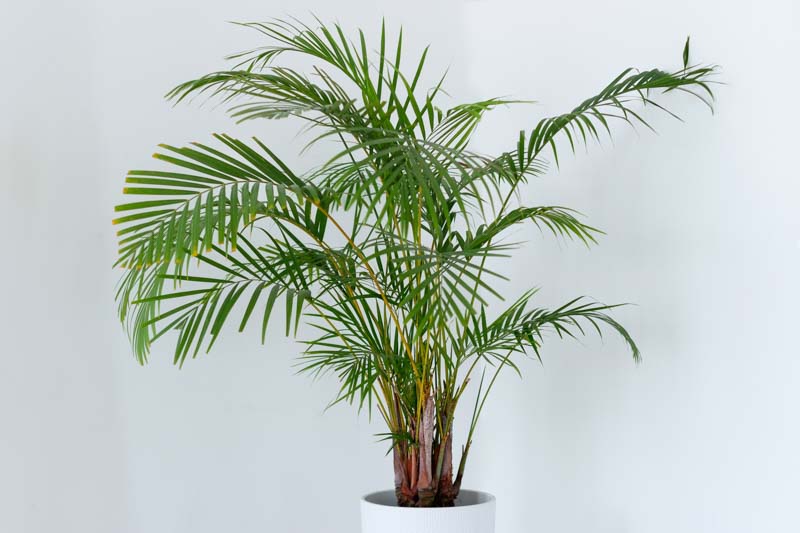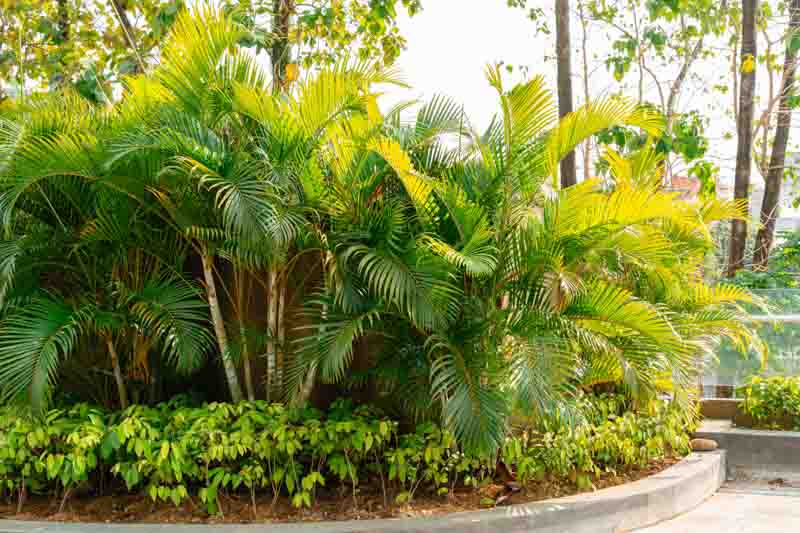Areca Palm, Bamboo Palm, Butterfly Palm, Cane Palm, Golden Yellow Palm, Golden-feather Palm, Madagascar Palm, Yellow Butterfly Palm,Yellow Palm, Areca lutescens, Chrysalidocarpus lutescens
Dypsis lutescens is a versatile and visually appealing palm that offers both aesthetic and environmental benefits. Its ease of care, coupled with its ability to improve air quality, makes it a popular choice for indoor and outdoor planting in suitable climates. Whether used as a standalone feature or part of a tropical landscape, the Areca Palm adds a touch of elegance and greenery to any setting.
Dypsis lutescens, commonly known as the Areca Palm or Butterfly Palm, is a graceful and popular palm characterized by its clustering, slender, golden-yellow stems and feathery fronds.
Native: It originates from the humid rainforests of Madagascar.
Plant Type and Habit: This evergreen, perennial palm is known for its clumping growth habit. The multiple stems grow closely together, creating a dense, bushy appearance.
Size: It grows at a moderate pace and typically reaches a height of 20-30 feet (6-9 m) with a spread of 10-20 feet (3-6 m) when grown outdoors. When grown indoors, it typically reaches heights between 6 to 8 feet (1.8 to 2.4 m).
Flowers: The palm produces small, yellowish flowers on branching inflorescences that emerge from among the fronds. Flowering usually occurs in late spring or early summer.
Fruits: Following flowering, it develops small, oval, greenish-yellow to orange fruits.
Foliage: The Areca Palm’s attractive, arching fronds, 6-8 feet long (180-240 cm) are pinnate, with narrow, long leaflets that emanate a lush, tropical feel. They range from deep green to light yellowish-green.
Trunk: The multiple trunks are slender, 2-4 inches wide (5-10 cm), smooth, and ringed with leaf scars. A notable feature is their golden-yellow color, which becomes more pronounced in sunlight.
Uses: Widely used as an ornamental plant, it’s popular in gardens, public spaces, and as an indoor plant due to its air-purifying qualities.
Hardiness: It’s hardy in USDA zones 10-11 and prefers a warm, humid climate, not tolerating cold temperatures well. Minimum Temperature: 32°F (0°C).
Award: Recipient of the prestigious Award of Garden Merit of the Royal Horticultural Society.
Wildlife: While not a significant attractor of wildlife, its dense foliage can offer shelter to small animals and birds in garden settings.
Toxicity: The Areca Palm is non-toxic, making it a safe option for households with pets and children.
Deer and Rabbit: It is generally not bothered by deer and rabbits.
Drought / Salt: This palm prefers consistent moisture and is not particularly drought-tolerant. It also has a fair salt tolerance.
Invasiveness: Dypsis lutescens is not typically considered invasive. However, care should be taken in similar climates to Madagascar to prevent unwanted spread.
Benefits: One of its primary benefits is air purification. Thanks to its exceptional purifying capabilities, it is frequently highlighted as one of the top indoor plants for eliminating a wide range of airborne toxins. In a household environment, a 6-foot (1.8-meter) Areca Palm can release about 1 quart (approximately 1 liter) of water daily through transpiration, effectively humidifying the air. Additionally, its lush appearance and clustering growth can create a natural privacy screen.

Light: Prefers bright, indirect sunlight. Avoid direct sun exposure, which can scorch the leaves.
Soil: Use well-draining potting soil. A mix designed for palms or cacti is ideal.
Water: Water when the top inch of soil becomes dry. Reduce watering in winter.
Humidity: Thrives in high humidity. Mist regularly or use a humidifier.
Temperature: Prefers warm conditions, ideally between 65-75°F (18-24°C). Avoid cold drafts and sudden temperature changes.
Fertilizer: Feed with a balanced liquid fertilizer during the growing season, every 4-6 weeks.
Pruning: Trim off any brown or yellowing fronds at the base. Avoid over-pruning.
Repotting: Repot every 2-3 years or when the roots become crowded.
Pests: Watch for spider mites, mealybugs, and scale insects. Treat infestations promptly.

Location: Plant in a location with bright, indirect sunlight. Can tolerate some direct morning sun.
Soil: Prefers fertile, well-draining soil. Amend with compost or peat moss if needed.
Watering: Keep the soil consistently moist but not waterlogged. More frequent watering may be needed in hot, dry weather.
Mulching: Apply mulch to retain soil moisture and regulate temperature.
Fertilizing: Use a palm-specific fertilizer during the growing season, following label instructions.
Temperature: Protect from frost.
Pruning: Remove dead or damaged fronds to maintain appearance and health.
Pests and Diseases: Check for common pests and treat them as needed. Avoid overwatering to prevent root rot.
| Hardiness |
10 - 11 |
|---|---|
| Climate Zones | 23, 24, H1, H2 |
| Plant Type | Palms - Cycads |
| Plant Family | Arecaceae |
| Common names | Areca Palm |
| Exposure | Full Sun, Partial Sun |
| Season of Interest |
Spring (Early, Mid, Late) Summer (Early, Mid, Late) Fall Winter |
| Height |
6' - 30' (180cm - 9.1m) |
| Spread |
6' - 20' (180cm - 6.1m) |
| Maintenance | Low |
| Water Needs | Average |
| Soil Type | Loam, Sand |
| Soil pH | Acid, Neutral |
| Soil Drainage | Well-Drained |
| Characteristics | Showy, Evergreen, Plant of Merit |
| Tolerance | Salt |
| Attracts | Birds |
| Garden Uses | Beds And Borders, Patio And Containers |
| Garden Styles | Coastal Garden, Mediterranean Garden |
| Hardiness |
10 - 11 |
|---|---|
| Climate Zones | 23, 24, H1, H2 |
| Plant Type | Palms - Cycads |
| Plant Family | Arecaceae |
| Common names | Areca Palm |
| Exposure | Full Sun, Partial Sun |
| Season of Interest |
Spring (Early, Mid, Late) Summer (Early, Mid, Late) Fall Winter |
| Height |
6' - 30' (180cm - 9.1m) |
| Spread |
6' - 20' (180cm - 6.1m) |
| Maintenance | Low |
| Water Needs | Average |
| Soil Type | Loam, Sand |
| Soil pH | Acid, Neutral |
| Soil Drainage | Well-Drained |
| Characteristics | Showy, Evergreen, Plant of Merit |
| Tolerance | Salt |
| Attracts | Birds |
| Garden Uses | Beds And Borders, Patio And Containers |
| Garden Styles | Coastal Garden, Mediterranean Garden |
How many Dypsis lutescens (Areca Palm) do I need for my garden?
| Plant | Quantity | |
|---|---|---|
| Dypsis lutescens (Areca Palm) | N/A | Buy Plants |
Create a membership account to save your garden designs and to view them on any device.
Becoming a contributing member of Gardenia is easy and can be done in just a few minutes. If you provide us with your name, email address and the payment of a modest $25 annual membership fee, you will become a full member, enabling you to design and save up to 25 of your garden design ideas.
Join now and start creating your dream garden!
Create a membership account to save your garden designs and to view them on any device.
Becoming a contributing member of Gardenia is easy and can be done in just a few minutes. If you provide us with your name, email address and the payment of a modest $25 annual membership fee, you will become a full member, enabling you to design and save up to 25 of your garden design ideas.
Join now and start creating your dream garden!